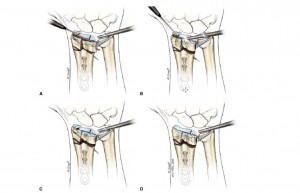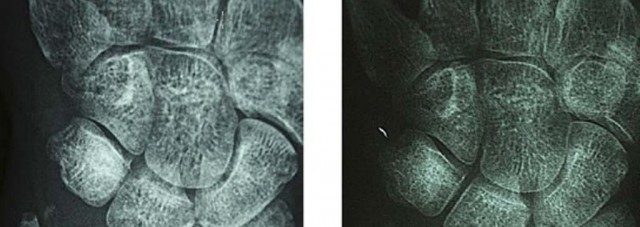Ci-dessous vous pouvez lire une traduction de traducteur humain en anglais. Vous avez également accès à l’original espagnol en cliquant sur le drapeau dans le coin supérieur droit. Ce lien vous donne accès à une version de traduction automatique de Google en français: https://goo.gl/qbWxbT
Dr Piñal addresses the characteristics of radius or Colles fractures, as well as their potential complications, sequelae and surgical solutions.
The radius fractures or Colles fractures are extraordinarily frequent, and -unfortunately- are often treated incorrectly.
For a long time, they’ve been considered benign wrist injuries, and so treated with plaster or other inadequate treatments. The result: numerous cases of patients with serious sequelae such as continuous pain or functional limitations.
Dr. Francisco del Piñal defends the existence of solutions for those who find themselves in this situation who, in their own words, “should not resign themselves, have to rebel against pain”. However, qualifies, these solutions must be known by the patient, what does not always happen (…).
Dr, do you regularly treat people with sequelae associated with radius fractures?
That’s right, in fact, the cases of sequelae of radius or Colles fractures can represent a 20% of the people we see in the clinic. This is not just statistics, since unlike an acute fracture, which can be easy to treat, in sequelae it is more complex to achieve a perfect result.
What kind of complications and scope have these sequelae?
As I pointed out before, it is a scenario of some difficulty. The complications are serious. Mainly pain, limited movement and lack of strength, what hinders the patient’s normal development of their daily tasks.
Broadly speaking, where is their origin?
They are caused by a misalignment of the joint or bone; any of these two things will provoke that the wrist does not work in optimal conditions (…) and a wrist, especially in the dominant hand, must be in perfect state to meet our daily needs.

Solutions? (…)
Yes, there exist. The ‘good news’ is that the sequelae and complications derived from radius or Colles fractures have a solution. Affected people don’t have to resign themselves to pain.
Although we don’t obtain the same results as when treating the original fracture, we have resources that can eliminate discomfort, improve the mobility of the affected area and its strength, that is, recover function.
Of course the time factor is fundamental in the correction of sequelae, since various elements of the wrist destructures as time passes. However, even ten years after the fracture, things can always be done to improve functionality.
However, the key is that the patient knows that his situation, after a poorly treated fracture, is not irreversible but there are alternatives. This, unfortunately, does not always occur, partly because several of the solutions to which I referred, in whose development I have personally participated, have been generated in recent years.
Nevertheless, the key is that the patient knows that his situation, after a poorly treated fracture, is not irreversible but there are alternatives. This, unfortunately, does not always occur, partly because several of the solutions to which I referred, in whose development I have personally participated, have been generated in recent years.

Precisely, if we talk about information, what are the alarm signals for the patient?, how can he notice that something has gone wrong in the treatment of his original fracture?
First of all, a wrist with a deformed appearance, also the excessive swelling of the operated area and, of course, to suffer a lot of pain during the rehabilitation process. These are unambiguous signs of inadequate treatment, that something is not right.
On the other hand, I return again on the importance of information and not resigning. “No more can be done”, is not a phrase that a person with complications after a radius or Colles fracture must accept without considering other possibilities (…)
Dr, technique, recovery process and prognosis, what can expect people who decide to ‘correct’ the fractured area?
The idea, the clinical approach, is always the same: to recreate the original fracture and re-align it, put it in the right place. To do this, we perform an osteotomy, that is, a cut in the bone in the spot where it was initially broken. Depending on the fracture point, arthroscopy, plates, etc. are used or not.
In most cases, the patient can begin to move the area immediately. He notices the improvement in a matter of days. The advance, as we have said, is remarkable.
In fact, one of the most common phrases I hear in consultation is “Dr, I forgot about the wrist”. It describes very well the relief that comes from leaving a situation where you feel pain every time you make the slightest movement.
Related content:
 es
es en
en fr
fr it
it ru
ru zh-hans
zh-hans
